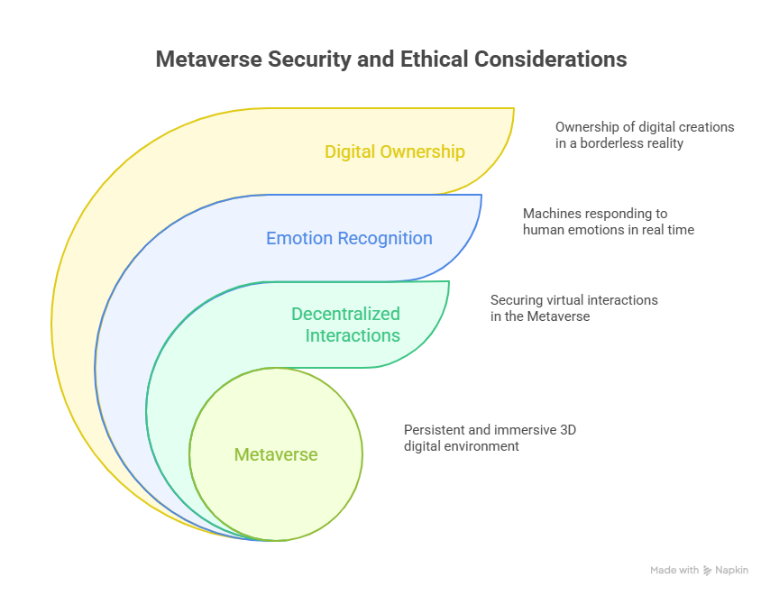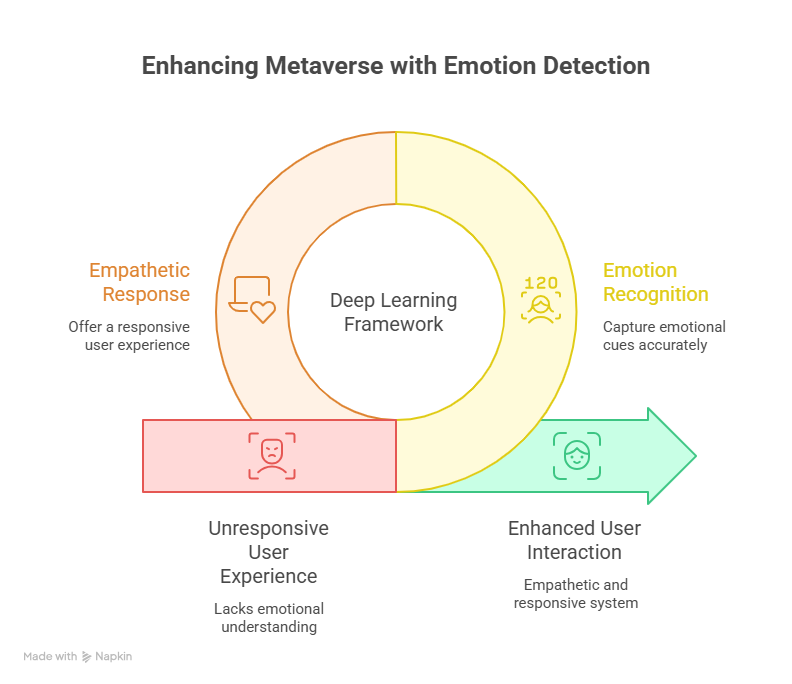By: Brij B. Gupta, Department of Computer Science and Information Engineering, Asia University, Taichung 413, Taiwan.
Abstract
As the Metaverse evolves from a speculative concept to a functional digital ecosystem, its implications for security, emotional intelligence, and intellectual property (IP) become increasingly critical. This blog explores how emerging technologies—such as deep learning, digital twins, emotion recognition systems, and blockchain—are being integrated into Metaverse applications, especially within the context of Industry 4.0. We delve into the challenges of safeguarding digital identities, detecting malicious behaviors, and ensuring content ownership in immersive environments. By examining state-of-the-art research, we aim to offer a roadmap for navigating the complex intersection of virtual spaces, user trust, and regulatory compliance in the Metaverse era.
Introduction
The Metaverse[1][2][3], envisioned as a persistent and immersive 3D digital environment [4][5], is no longer confined to science fiction. With tech giants investing heavily in its infrastructure, the Metaverse now influences domains ranging from entertainment and education to manufacturing and healthcare. Yet, its rapid development introduces pressing questions: How do we secure decentralized virtual interactions? Can machines recognize and respond to human emotions in real time? Who owns digital creations in a borderless, programmable reality?
These concerns are not merely theoretical. As the Metaverse integrates with Industry 4.0, it becomes a crucial layer in digital transformation strategies. Thus, addressing security vulnerabilities, enhancing emotional AI, and redefining IP laws are imperative for its sustainable growth.

1. Emotion Recognition: The Human Layer in Virtual Environments
A core feature of immersive environments is the ability to understand and respond to users’ emotions. Facial emotion detection systems, powered by deep learning, are gaining traction within Metaverse applications, especially for virtual collaboration, digital avatars, and training simulators.
Gupta et al. [1] demonstrated a deep learning-based framework for facial emotion recognition tailored for Metaverse environments. The system accurately captured emotional cues, offering a more empathetic and responsive user experience. This advancement not only enhances interaction but also plays a key role in mental health monitoring, customer feedback analysis, and adaptive learning environments.

2. Intellectual Property Rights in the Metaverse
With user-generated content (UGC) forming the backbone of Metaverse platforms—avatars, skins, virtual art, NFT-based assets—the question of ownership is more complicated than ever.
In their study, Gupta et al. [7] examined the evolution of intellectual property rights (IPR) in Metaverse-aligned Industry 4.0 contexts. They highlight challenges in enforcing copyright, managing digital duplication, and authenticating originality in a decentralized environment. Existing laws are inadequate to address virtual real estate, digital fashion, or metaverse-native inventions.
This complexity necessitates an IPR framework grounded in blockchain verification, smart contracts, and decentralized content registries, thus allowing creators to assert rights and receive fair compensation.
3. Security and Trust in Immersive Spaces
Security in the Metaverse involves more than preventing unauthorized access—it encompasses identity protection, data integrity, avatar impersonation, and behavioral monitoring. As avatars become digital extensions of individuals, the risks of deepfake-based social engineering and virtual stalking rise sharply.
Sedik et al. [8] introduced an AI-enabled framework for digital forgery analysis and interaction monitoring in smart communities. Their model, though originally intended for smart cities, is highly applicable in Metaverse platforms, where synthetic media and behavioral manipulation can disrupt user trust and safety.
Further, Arya et al. [9] applied digital twins for malicious node detection in vehicular networks. In the Metaverse, digital twins of users or systems can help simulate threat scenarios and identify vulnerabilities proactively.
4. Blockchain and Authentication
To ensure trust and provenance in the Metaverse, blockchain plays a pivotal role. From identity validation to transaction logging and copyright protection, blockchain’s immutability offers a secure backbone for decentralized environments.
Zhang et al. [10] proposed a lightweight cross-domain authentication protocol for the Industrial Internet, which can be extended to Metaverse applications for seamless yet secure access across multiple virtual domains and services.
5. The Ethical and Legal Conundrum
Despite technological advancements, the ethical implications of emotion tracking, avatar surveillance, and data monetization remain unresolved. Who governs the ethical use of emotional data? How should avatar behavior be regulated?
Moreover, jurisdictional conflicts arise as Metaverse platforms span continents. Content created in one legal system may violate norms in another, making enforcement of IP rights and data protection laws highly fragmented.
To address this, hybrid regulatory frameworks combining international cyberlaw, platform-level governance, and user-informed consent models are essential.
6. Application Scenarios and Use Cases
Let’s explore how the above themes are being practically implemented across sectors:
Application Area | Technology Used | Key Concern Addressed |
|---|---|---|
Virtual Classrooms | Emotion Detection AI [6] | Real-time engagement tracking |
NFT Marketplaces | Blockchain, Smart Contracts [7] | Ownership verification |
VR Social Platforms | Forgery Detection AI [8] | Avatar impersonation & fraud |
Industrial Simulation Twins | Digital Twin Security [9] | System vulnerability detection |
Virtual Conferencing | Cross-Domain Auth Protocols [10] | Seamless yet secure access |
Conclusion
As the Metaverse redefines how we interact, express, and build value in digital spaces, the urgency to address its security, emotional intelligence, and intellectual property challenges cannot be overstated. This immersive layer of Industry 4.0 is not just a visual interface—it’s a living ecosystem of data, identity, and creativity.
From facial emotion recognition to decentralized authentication and IPR protection, the research discussed in this article outlines a path toward a secure, ethical, and innovation-friendly Metaverse. Future developments must ensure that technological advancement goes hand-in-hand with transparency, inclusiveness, and regulation.
As we continue navigating the Metaverse, let us not forget that security and creativity are not opposing forces—they are complementary pillars on which the digital society of tomorrow must stand.
References
- Cheng, S. (2023). Metaverse. In Metaverse: Concept, content and context (pp. 1-23). Cham: Springer Nature Switzerland.
- Wang, Y., Su, Z., Zhang, N., Xing, R., Liu, D., Luan, T. H., & Shen, X. (2022). A survey on metaverse: Fundamentals, security, and privacy. IEEE communications surveys & tutorials, 25(1), 319-352.
- Fan, S., Yecies, B., Zhou, Z. I., & Shen, J. (2024). Challenges and opportunities for the web 3.0 metaverse turn in education. IEEE Transactions on Learning Technologies, 17, 1935-1950.
- Shiode, N. (2000). 3D urban models: Recent developments in the digital modelling of urban environments in three-dimensions. GeoJournal, 52(3), 263-269.
- Jian, H., Liao, J., Fan, X., & Xue, Z. (2017). Augmented virtual environment: fusion of real-time video and 3D models in the digital earth system. International Journal of Digital Earth, 10(12), 1177-1196.
- Gupta, B. B., Gaurav, A., Chui, K. T., & Arya, V. (2024, January). Deep learning-based facial emotion detection in the Metaverse. In 2024 IEEE International Conference on Consumer Electronics (ICCE) (pp. 1–6). IEEE.
- Gupta, B. B., Gaurav, A., Arya, V., & Alhalabi, W. (2024). The evolution of intellectual property rights in Metaverse-based Industry 4.0 paradigms. International Entrepreneurship and Management Journal, 20(2), 1111–1126.
- Sedik, A., Maleh, Y., El Banby, G. M., Khalaf, A. A., Abd El-Samie, F. E., Gupta, B. B., … & Abd El-Latif, A. A. (2022). AI-enabled digital forgery analysis and crucial interactions monitoring in smart communities. Technological Forecasting and Social Change, 177, 121555.
- Arya, V., Gaurav, A., Gupta, B. B., Hsu, C. H., & Baghban, H. (2022, December). Detection of malicious node in VANETs using digital twin. In International Conference on Big Data Intelligence and Computing (pp. 204–212). Springer.
- Zhang, T., Zhang, Z., Zhao, K., Gupta, B. B., & Arya, V. (2023). A lightweight cross-domain authentication protocol for trusted access to industrial internet. International Journal on Semantic Web and Information Systems, 19(1), 1–25.
Cite As
Gupta B.B. (2025) Navigating the Metaverse: Security, Emotions, and Intellectual Property, Insights2Techinfo, pp.1